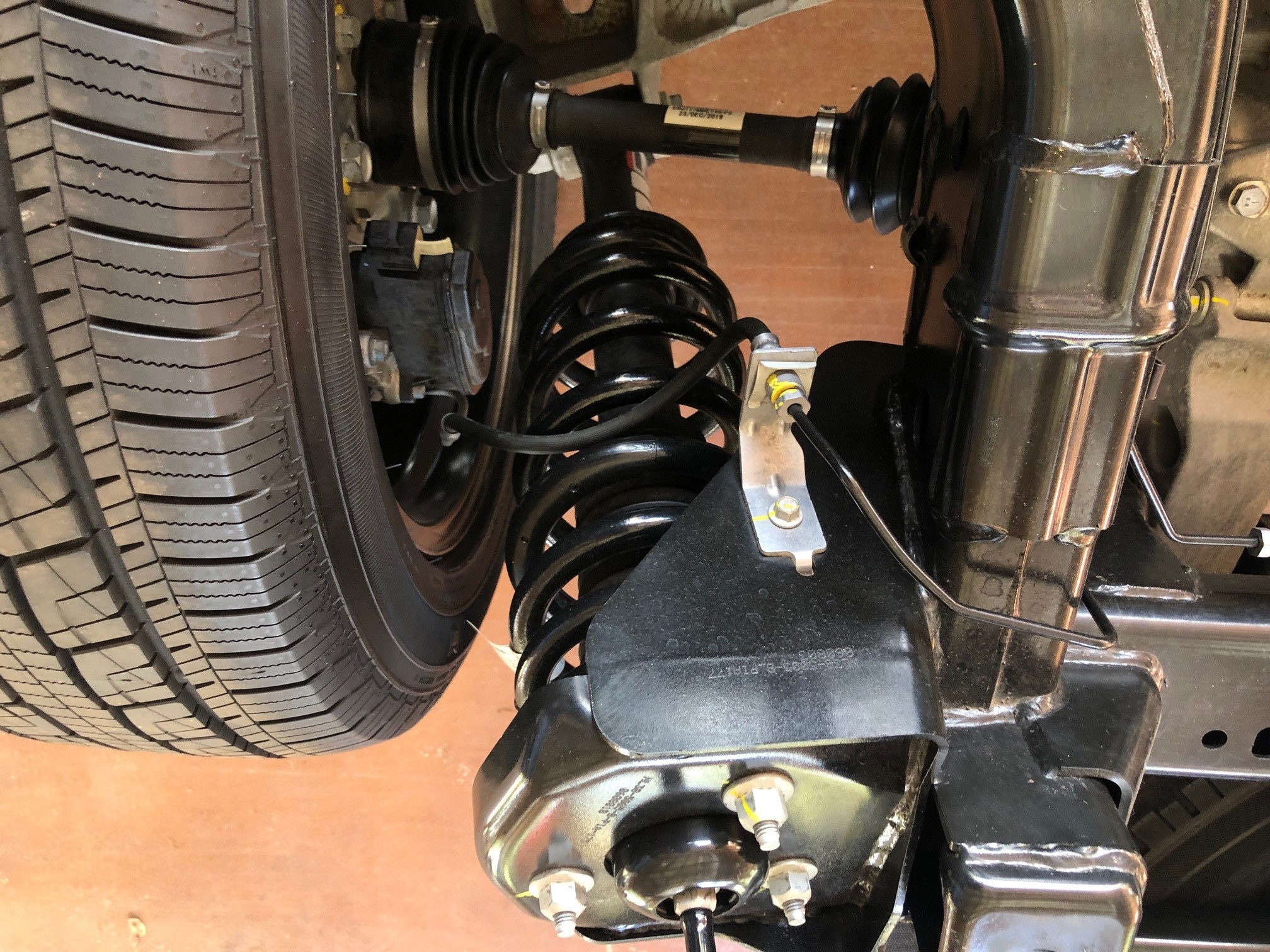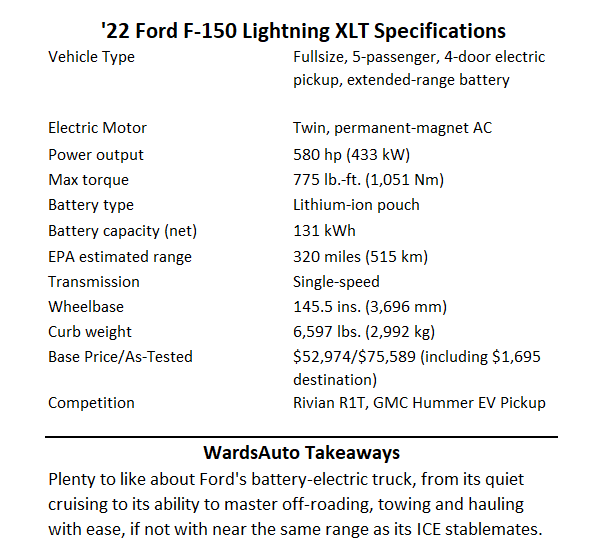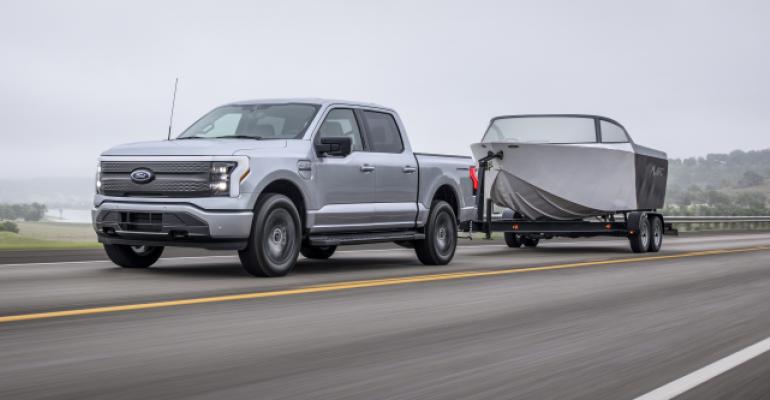SAN ANTONIO, TX – It loses a little swagger entering the interstate on a steep uphill while towing an 8,600-lb. (3,901-kg) boat and trailer, and we note a touch of torque steer, but there is nary a peep of harsh noise from the twin electric motors propelling the Ford F-150 Lightning up the slope.
Unlike the kind of metallic valve and piston clatter and induction and exhaust roar you’d hear from a hard-pressed gasoline or diesel powerplant, the Lightning’s front and rear motors take on the challenge in near silence, with just the slightest tire and wind noise invading the cabin.
Producing 580 hp and 775 lb.-ft. (1,051 Nm) of torque when equipped with an extended-range battery, the Lightning easily outdoes even the highest output gasoline-powered F-150 on those measures.
And while its 320-mile (515-km) range falls short of the traditional truck, Ford engineers calculate loss of range when towing or hauling heavy loads is equivalent to the penalty seen in internal-combustion-engine models. The Lightning is rated to tow up to 10,000 lbs. (4,536 kg) and can haul up to 2,235 lbs. (1,014 kg).
Ford says those numbers, along with the Lightning’s unique capabilities such as a 14.1-cu.-ft. (400-L) front trunk (below, left), the ability to power a home during an outage, or bring juice to a remote worksite or campsite, are bringing new buyers into the Ford fold.
Of the 200,000 potential Lightning buyers on the waiting list, 50% are new to trucks and 70% are new to Ford, says Linda Zhang, chief engineer. She notes that while the truck may appear the same – sharing some aluminum body panels with its ICE sibling – the Lightning is “modernized” with a new frame to support its battery pack and a new independent rear suspension previously never offered on a fullsize Ford truck.
We put the Lightning through its paces over the course of two days here in Texas, sampling on- and off-road driving, testing BlueCruise hands-free Level 2+ assistance, the aforementioned towing and even a short autocross course.
On the highway, the electric pickup is quiet, with just a whisper of wind noise from the outside mirror housing breaking the interior silence (Lightning Pro interior, below). With instant torque from launch, there are no issues getting the 6,590-lb. (2,989-kg) unladen truck moving and we detect no drop-off in power at higher speeds. The Lightning punches from 45-70 mph (72-113-km/h) in an instant, with higher speeds coming without any obvious decline in output.
The low-mounted battery no doubt contributes to the truck’s planted feel, augmented by the new IRS and coil springs that smooth the ride and eliminate the last vestiges of leaf-spring and solid-axle suspension harshness and wheel hop.
In this application, BlueCruise seems to allow a bit of latitude – up to 10 seconds or so – for the driver to glance away from the road to manage the touchscreen or chat with a passenger. We appreciate that more relaxed attitude compared with systems that demand constant focus on the road. That said, the Lightning’s lane-keeping system could use some tightening to confidently keep the vehicle within the lane markers.
Our observed efficiency during a day of on-road cruising ranged from 1.9-mi/kWh to 2.2 mi./kWh, translating to 249-288 miles (401-463 km) of range from the 131-kWh extended-range battery in our Platinum-trim tester.
Day 2 features a variety of exercises, including off-roading that shows off an XLT-trim truck’s ability to clamber over boulders, up tough inclines and through watery obstacles, all during a 90° F (32° C) day that pushes battery temperature management to the limit.
We occasionally engage the truck’s mechanical rear locker to assist with the roughest obstacles and wish for one-pedal operation, which Ford engineers say they left off the option list because they wanted to avoid the kind of severe response the on/off pedal reaction might incur.
Observed off-road mileage dips to 0.7 mi./kWh or 92 miles (148 km) of range, similar to the mileage penalty we noted during our towing exercise.
Ford says the Lightning’s towing and hauling penalty is comparable to that of an ICE-powered F-150. For comparison, the least-efficient 5.0L V-8 F-150 4x4 with an EPA combined rating of 19 mpg (12.4 L/100 km), equipped with the smallest, 23-gallon (87 L) fuel tank would have a range of 437 miles (703 km). If the same penalty is applied, the gas F-150’s commensurate range would be about 126 miles (203 km).
We suspect most truck buyers who tow or haul regularly would opt for a larger 26-gallon (98-L) or even 36-gallon (136-L) tank, if available, to increase their range. For now, the extended-range battery is as big as the Lightning’s “tank” gets.
Towing and hauling questions aside, where the Lightning really shines is in ride and handling, thanks to the independent rear suspension (below, left) and near 50:50 weight distribution, the latter never close to being achieved in ICE pickups.
Add in the Lightning’s ability to power a household during a blackout, or a remote campsite or jobsite, or to provide a “jump” start to a discharged BEV, and it’s a rolling electricity-storage unit.
The company also touts its work in aiding BEV owners in finding available charging outlets along their routes through the FordPass Power My Trip mapping system. Its Intelligent Range function factors in everything from driving behavior, climate control use, traffic speed, outside temperature and routing to serve up recommended charging options along the way. When towing, the system also uses trailer weight to recommend charge points.
The Ford BlueOval Charge Network provides more than 20,500 charging locations and more than 70,000 outlets, including 7,300 DC fast chargers. At the 150-kW rate available through Electrify America DC chargers, the Lightning can fill up from 15% to 80% charged in 41 minutes, Ford says.
With all those orders in the bank, Ford is busy cranking up capacity to meet demand for its BEV pickup, following on the success of the Mach-E CUV and Transit EV delivery van. The automaker expects it will hit an annual production rate of 150,000 Lightnings in 2023 at the Rouge Electric Vehicle Center in Dearborn, MI.
The company builds electric motors and transaxles for the Lightning at the Van Dyke (MI) Electric Powertrain Center and assembles its batteries at the Rawsonville (MI) Components Plant.





